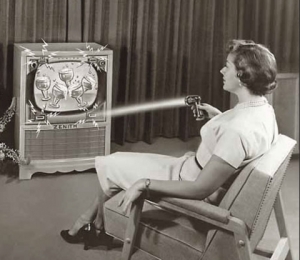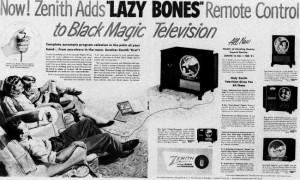It’s interesting to think that the first handheld media device ever to be invented is considered to be the remote control. It was a new piece of technology that drastically changed the experience of watching broadcast television by allowing users the opportunity to control what and how they watched television and in turn, enables passive viewers into active viewers. The invention of the remote control did a lot more than just save viewers the trouble of getting up to manually change the channel or volume dial on the television set. It has changed the entire television watching experience by giving viewers the ability to have control over content, leading them to a greater chance of frequent channel changes or surfing. Robert V. Bellamy and James W alker explain that for them, “the new paradigm of the remote was best understood as a ‘second-generation’ television audience.”(Bennet&Strange, 56) This new active viewing incorporated much more “zipping” and “zapping”, terms used to describe fast-forwarding through recorded content or flipping through a series of channels. This device surely led to a more pleasurable television watching experience for the viewer, however, it also caused broadcast companies to have to come up with more creative strategies to attract and keep their audiences. This means that as technology progresses, television remotes must adapt to fit the television user base. In order to do so, remotes will be designed with multiple functions already in mind, such as customizable buttons, specific buttons for a DVD player function, or even the very versatile “universal” remote.
alker explain that for them, “the new paradigm of the remote was best understood as a ‘second-generation’ television audience.”(Bennet&Strange, 56) This new active viewing incorporated much more “zipping” and “zapping”, terms used to describe fast-forwarding through recorded content or flipping through a series of channels. This device surely led to a more pleasurable television watching experience for the viewer, however, it also caused broadcast companies to have to come up with more creative strategies to attract and keep their audiences. This means that as technology progresses, television remotes must adapt to fit the television user base. In order to do so, remotes will be designed with multiple functions already in mind, such as customizable buttons, specific buttons for a DVD player function, or even the very versatile “universal” remote.
Julian Thomas explains in When Digital Was New: The Advanced Television Technologies of the 1970s and the Control of Content, “The remote is designed to embody a carefully crafted set of technological and commercial compromises, enabling the viewer certain degrees of control over the content available but restricting certain critical options.” This explains why remotes allow users to only fast-forward through commercials, rather then allowing the option to skip them altogether, or the case of needing more than one remote to control the audiovisual display. Thomas goes on to explain how newer television technologies have been created to better manage the movement of audiovisual content. One such advancement is the HDMI and its new way of connecting electronic devices through a single connection, replacing old er DVI connections. HDMI not only offers the bandwidth to allow the highest current resolution, but also allows the devices connected to one another to be controlled through one independent remote control and rid the confusion of needing multiple remotes for different functions. In many cases, universal remotes can be just as frustrating and confusing to not only set up, but actively use without somehow deactivating certain functions. In my experience, I’ve had many negative encounters with “universal” remotes for that exact reason, but for many, it is the exact kind of control they want from one handheld device. As Thomas explains on page 72, “A chaotic plethora of devices and communication standards frustrates viewers, but control is likely to prove just as elusive for those who most wish to manage television.”
er DVI connections. HDMI not only offers the bandwidth to allow the highest current resolution, but also allows the devices connected to one another to be controlled through one independent remote control and rid the confusion of needing multiple remotes for different functions. In many cases, universal remotes can be just as frustrating and confusing to not only set up, but actively use without somehow deactivating certain functions. In my experience, I’ve had many negative encounters with “universal” remotes for that exact reason, but for many, it is the exact kind of control they want from one handheld device. As Thomas explains on page 72, “A chaotic plethora of devices and communication standards frustrates viewers, but control is likely to prove just as elusive for those who most wish to manage television.”
Sources:
Thomas, Julian. “When Digital Was New: The Advanced Television Technologies of the 1970s and the Control of Content.” Television as Digital Media. Comp. James Bennett and Niki Strange. Durham, NC: Duke UP, 2011. 52-72. Print.

Leave a comment